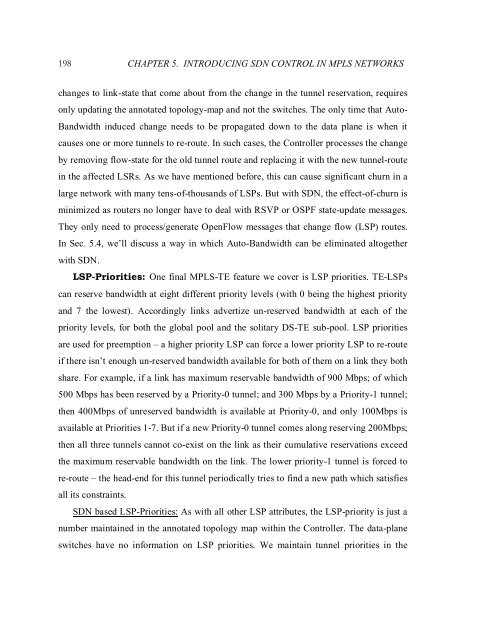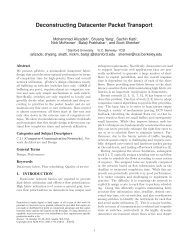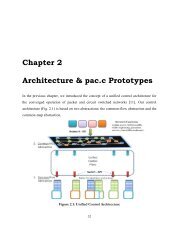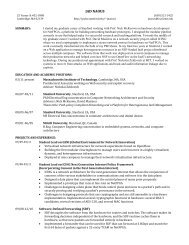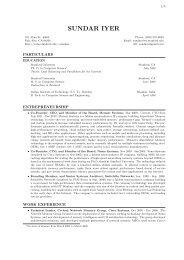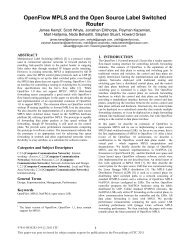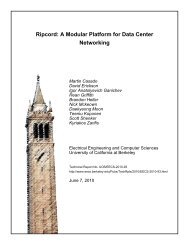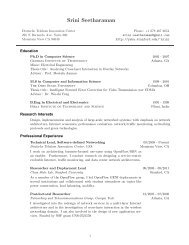Chapter 5 Introducing SDN Control in MPLS Networks - High ...
Chapter 5 Introducing SDN Control in MPLS Networks - High ...
Chapter 5 Introducing SDN Control in MPLS Networks - High ...
Create successful ePaper yourself
Turn your PDF publications into a flip-book with our unique Google optimized e-Paper software.
198 CHAPTER 5. INTRODUCING <strong>SDN</strong> CONTROL IN <strong>MPLS</strong> NETWORKSchanges to l<strong>in</strong>k-state that come about from the change <strong>in</strong> the tunnel reservation, requiresonly updat<strong>in</strong>g the annotated topology-map and not the switches. The only time that Auto-Bandwidth <strong>in</strong>duced change needs to be propagated down to the data plane is when itcauses one or more tunnels to re-route. In such cases, the <strong>Control</strong>ler processes the changeby remov<strong>in</strong>g flow-state for the old tunnel route and replac<strong>in</strong>g it with the new tunnel-route<strong>in</strong> the affected LSRs. As we have mentioned before, this can cause significant churn <strong>in</strong> alarge network with many tens-of-thousands of LSPs. But with <strong>SDN</strong>, the effect-of-churn ism<strong>in</strong>imized as routers no longer have to deal with RSVP or OSPF state-update messages.They only need to process/generate OpenFlow messages that change flow (LSP) routes.In Sec. 5.4, we’ll discuss a way <strong>in</strong> which Auto-Bandwidth can be elim<strong>in</strong>ated altogetherwith <strong>SDN</strong>.LSP-Priorities: One f<strong>in</strong>al <strong>MPLS</strong>-TE feature we cover is LSP priorities. TE-LSPscan reserve bandwidth at eight different priority levels (with 0 be<strong>in</strong>g the highest priorityand 7 the lowest). Accord<strong>in</strong>gly l<strong>in</strong>ks advertize un-reserved bandwidth at each of thepriority levels, for both the global pool and the solitary DS-TE sub-pool. LSP prioritiesare used for preemption – a higher priority LSP can force a lower priority LSP to re-routeif there isn’t enough un-reserved bandwidth available for both of them on a l<strong>in</strong>k they bothshare. For example, if a l<strong>in</strong>k has maximum reservable bandwidth of 900 Mbps; of which500 Mbps has been reserved by a Priority-0 tunnel; and 300 Mbps by a Priority-1 tunnel;then 400Mbps of unreserved bandwidth is available at Priority-0, and only 100Mbps isavailable at Priorities 1-7. But if a new Priority-0 tunnel comes along reserv<strong>in</strong>g 200Mbps;then all three tunnels cannot co-exist on the l<strong>in</strong>k as their cumulative reservations exceedthe maximum reservable bandwidth on the l<strong>in</strong>k. The lower priority-1 tunnel is forced tore-route – the head-end for this tunnel periodically tries to f<strong>in</strong>d a new path which satisfiesall its constra<strong>in</strong>ts.<strong>SDN</strong> based LSP-Priorities: As with all other LSP attributes, the LSP-priority is just anumber ma<strong>in</strong>ta<strong>in</strong>ed <strong>in</strong> the annotated topology map with<strong>in</strong> the <strong>Control</strong>ler. The data-planeswitches have no <strong>in</strong>formation on LSP priorities. We ma<strong>in</strong>ta<strong>in</strong> tunnel priorities <strong>in</strong> the


